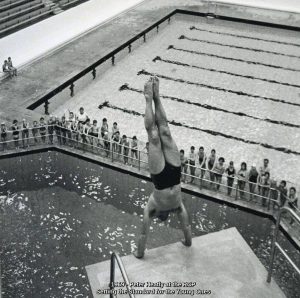Diving

Diving was introduced into the Olympic Games in 1904 but previously Graceful Diving competitions were commonplace at Club Galas.
The first Scottish Graceful Diving Championship took place in 1889, with each competitor performing four styles of dive: low, medium and high dive from the pool side and a surface or duck dive from the water. Each competitor made two dives of each style and the following points were awarded:
Throw Off – 1pt, Postn in air – 1pt, Ent to water – 1pt, Ret to surface – 1pt, Max pts – 32
The competition, in the 1940s, consisted of four dives: Plain, Shallow, Running Plain and Running Swallow. Each dive carried a maximum of 10 points which were awarded for the dive “as a whole”.
By 1920 the Olympic Games swimming, diving and water polo programmes were well established and they were beginning to influence the domestic activities of competing nations. however the S.A.S.A was unable to develop a diving scheme as suitable Olympic standard facilities were non-existent.
In 1924 it was decided not “to devote any time to the tuition of Olympic Diving until proper diving stages have been erected in Scotland”.
To maintain awareness, the S.A.S.A offered to provide municipal authorities with plans for diving stages.
It also printed the Olympic competition rules for diving in its National Handbook in the hope that they could be extended to the S.A.S.A. championship whenever practicable.
Between the wars municipal authorities played important role in recreational facility provision and public provision was at its height in the seaside resorts.
By 1940 there were ten open-air pools with 3 metre diving boards and the pools at Arbroath, Port Seton and Portobello also had 10 metre boards and depths of 15 feet.
The S.A.S.A. started a Springboard Championship in 1936 although there were relatively few divers in Scotland and the winner was D. Hatton, St. Thomas A.S.C., Arbroath. The introduction of the Springboard Championship coincided with the opening of Europe’s largest open-air pool at Portobello which was superbly equipped for diving.
Members of Edinburgh University S.C., which included two overseas students who were divers, were amongst its first users and wasted no time in making full use of the Portobello facilities. Among the enthusiastic group of young boys who were fascinated by the acrobatic feats of the students was Peter Heatly.
He trained with the divers throughout the summer of 1937 and before the end of the year created a sensation by winning the East District Graceful Diving Championship at the age of 12.
By 1949 he was the best diver in Britain and in the next ten years he won numerous international contests.
After 1950 the S.A.S.A. established a Diving Committee which included Peter Heatly and several very experienced administrators, such as Willie Foulds, Jock Coutts, James Grossart and James Amos formulated a comprehensive development programme.
A teacher’s certificate was introduced in 1950 in an attempt to increase the number of teachers and improve teaching quality.
A proficiency award scheme was also introduced in 1950 to popularise diving and improve its quality.
The S.A.S.A. also organised some very successful residential training courses and during June 1954 organised a National Course for swimming, water polo and diving coaches at Butlin’s Holiday Camp, Ayr at which twelve candidates were awarded the Diving Instructors’ Certificate.
In 1958 Jock Coutts, the S.A.S.A. Secretary, noted:
“Scottish diving is fast improving, Peter Heatly is very confident that he has one or two very good youngsters coming along to uphold our newly won position in this side of the sport.”
Convenors Amos and Heatly and Secretary Coutts were instrumental in orchestrating these achievements but there was still a lot of work to be done particularly in womens’ diving.
Unfortunately, throughout the period, their efforts were constantly frustrated by a lack of indoor facilities of Olympic standard and quality.
In 1951, James Amos had complained about: “the serious lack of indoor diving facilities in the central Scotland districts” and although a first class, self-contained facility was built in Edinburgh in 1970, in 1973 Bill Black, the S.A.S.A. Secretary, wrote, “the diving fraternity are few in number and have an uphill task seeking facilities outside the Royal Commonwealth Pool”.
In 2021, there have been marginal improvements with the provision of facilities, with the opening of facilities in Aberdeen, however they still have cause for complaint.

